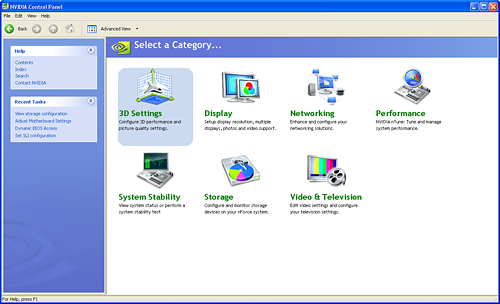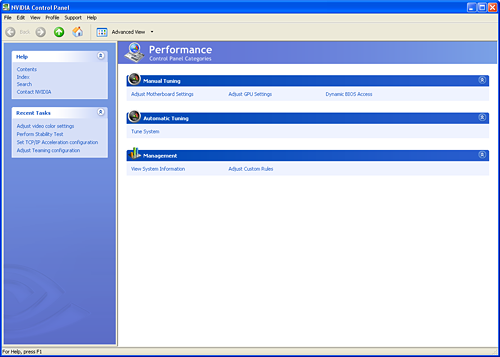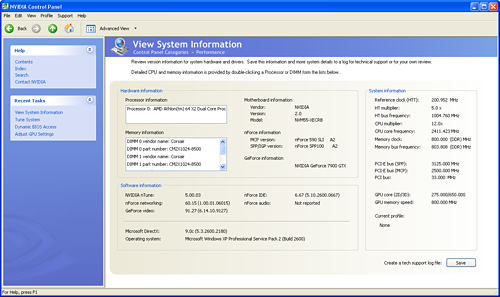nForce 500: nForce4 on Steroids?
by Gary Key & Wesley Fink on May 24, 2006 8:00 AM EST- Posted in
- CPUs
Improved Feature: Control Panel / nTune 5.0
One of most interesting features of the nForce 500 launch is the revamped control panel and nTune 5.0 performance applications. NVIDIA has combined all of their various program applets into an integrated control panel to provide a common user interface, a common interface that certainly makes it easier for the user to control the various functions of the board and video (NVIDIA based) from a central point. |
| Click to enlarge |
The new control panel offers configuration sections for 3D Settings for NVIDIA GPUs, Display settings, Networking options, Performance, System Stability testing, Storage, and Video/Television settings. The majority of information contained in each section will already be familiar to those with nForce4 boards, only with the same look and feel as the other control panels as well as some extended configuration options.
 |
| Click to enlarge |
A new application being featured is a System Stability test program that will run application level stress testing on the platform or on an individual component for a user specified amount of time. We found the application would generally fail settings that were a little more conservative than we utilize in stress testing, but it is nice to know the program will err on the safe side.
 |
| Click to enlarge |
The most interesting application is nTune 5.0 that can be found by clicking the Performance icon. nTune has undergone a complete transform and now includes the ability to dynamically write a significant number of performance settings directly to the BIOS without requiring a reboot. You also have the option for letting the system dynamically create an overclocking profile and automatically adjust the BIOS settings under the Automatic Tuning section.
 |
| Click to enlarge |
The Adjust Motherboard Settings section is certainly the most interesting of the performance oriented applets as changes in these fields are dynamically written to the BIOS. The settings can be saved in profiles that can be loaded within Windows without having to reset the system and enter the BIOS. This can help with situations where optimal settings for games might differ from those for audio/video playback. The system also allows for automatic or direct fan speed control on supported board headers.
 |
 |
| Click to enlarge |
The Dynamic BIOS Access section offers the ability to change BIOS setting in four different categories that will take effect on reboot. The two sections not displayed are for power management and peripheral settings.
 |
| Click to enlarge |
 |
NVIDIA also includes a System Information utility along with a Windows based monitoring application. Overall, the polished look, feel, and operation of the new control panel along with the performance improvements offered in nTune 5.0 has raised the bar for user enhancements offered by the core logic and motherboard suppliers.










64 Comments
View All Comments
xsilver - Wednesday, May 24, 2006 - link
is there going to be a 5xx nvidia chipset to support conroe?the lack of performance on AM2 makes this chipset highly unexciting
Gary Key - Thursday, May 25, 2006 - link
Yes, it is shaping up to be a very good chipset performance wise with Conroe. ;-)
The main issue with the nf5 chipset actually resides with the AM2 not really being any different than S939 except for the memory controller changes. As in the past, performance will improve once AMD does their memory controller tuning and the bios engineers have more time with the platform. Also, if you could get this board to run at 400fsb with 1:1 memory and 1T being stable, it would be a killer.
Lonyo - Wednesday, May 24, 2006 - link
Is this the same Foxconn board that AMDZone found was poor compared to the Asus NF5 board?http://www.amdzone.com/modules.php?op=modload&...">http://www.amdzone.com/modules.php?op=m...q=viewar...
Gary Key - Wednesday, May 24, 2006 - link
Yes, however, the performance of the Asus board with the latest bios improved scores in certain benchmarks. However, without knowing the bios settings that AMDZone used, it is hard to determine if the new board revision from Asus or bios made a difference. We have already received bios updates for all the boards in our coming roundup.Some have made a slight performance difference, some corrected some early test issues we found. The Foxconn board is a very solid setup and still has improvement potential. We found it to be representative of the initial performance results with the nForce 500. As time goes by and the bios engineers have time to properly tune the boards, we are sure there will be some performance improvements but nothing drastically different from what we are seeing today.